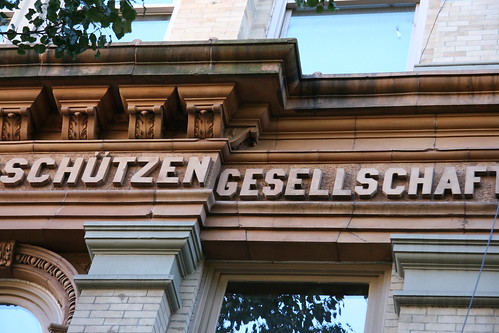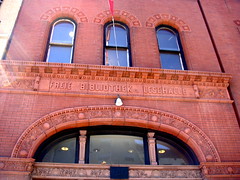 Sophie Hoeller Signs of the East Village’s former notoriety as Little Germany can still be found in pockets around the community. Here, the former German-American Shooting Hall at 12 St. Marks Place.
Sophie Hoeller Signs of the East Village’s former notoriety as Little Germany can still be found in pockets around the community. Here, the former German-American Shooting Hall at 12 St. Marks Place.Oktoberfest – the 200-year-old homage to German beer – and arguably the most identifiably German thing next to sauerkraut, kicked off this weekend. But you don’t have to cross the Atlantic to partake. In fact, you don’t even have to leave the neighborhood.
Most of us are well aware of the Lower East Side’s Jewish roots, but many don’t know that what is now called the East Village used to be known as “Kleindeutschland,” or Little Germany, home to German grocery stores, restaurants, beer gardens, libraries, theaters, shooting clubs, schools and churches.
During its heyday between 1850 and 1880, as many as 400,000 Germans called the East Village and Lower East Side their home. During those years only Vienna and Berlin had more German speakers. Had Little Germany been an actual city in Germany, it would have been the fifth largest.
Little Germany spanned 400 blocks formed by about six avenues and 40 streets, according to Stanley Nadel’s book “Little Germany: Ethnicity, Religion, and Class in New York,” published in 1990. Tompkins Square Park was the heart of the area; the Bowery marked the western border, and 18th Street, the northern.
Few vestiges remain. At 12 St. Marks Place the words “Deutsch-Amerikanische Schützen-Gesellschaft Halle” and “Einigkeit macht Stark” decorate the buildings’ awnings. The former German-American shooting club is marked with the slogan “unity makes strong.” Today, the building offers free yoga lessons as the home of Yoga To The People.
Another building, on Third Avenue and St. Marks, reads “Deutsches Dispensary,” and “Freie Bibliothek und Lesehalle.” The former hospital and public library is now squished between a Starbucks and a Subway sandwich shop.
Though stores with German roots can still be found all over the metro area, Little Germany has practically vanished. Still, a few German places in the old ‘hood, authentically run by German ex-pats, is keeping history alive.
 Sophie Hoeller The Freie Bibliothek und Lesehalle, a former public library, at Third Avenue and St. Marks Place.
Sophie Hoeller The Freie Bibliothek und Lesehalle, a former public library, at Third Avenue and St. Marks Place.Take Wechsler’s Currywurst on Seventh Street and First Avenue. It’s a veritable German sausage shrine, opened by Andre Wechsler, 38, from Hamm, Germany, in February 2009. Seeking a career change, the former accountant was looking for a niche when he realized that the currywurst he was bred on and missed so dearly was nowhere to be found in New York. The sliced sausage covered in a ketchupy but sweet, curry-spiced sauce became his niche.
Sausage runs in his blood—his great-grandparents were butchers from Bavaria. They sternly stare down from inside frilly picture frames on the exposed brick walls, next to the Wechsler family crest.
Though Mr. Wechsler said that it wasn’t his goal to showcase German culture, the largely German staff, schnitzel, sauerkraut and leberkäs, flags from various German cities and wooden currywurst picks make the small space with only 10 wooden stools and two communal tables rather authentically German.
From Sept. 19 to Oct. 3, Wechsler’s honors the Oktoberfest by offering $6 weisswurst and $8 leberkäs daily from 6 p.m.
Further east on Seventh Street and Avenue C sits another German establishment, Zum Schneider.
The indoor beer garden was opened by Sylvester Schneider, 45, from Bavaria, in August 2000. Yearning for summers spent in Bavarian beer gardens, he said he too opened his haunt out of homesickness.
Though outdoor space is available, it is the inside that provides atmosphere and authenticity. Communal tables, oompah music, singing, the occasional yodel, Bavarian flags and a framed portrait of a critical looking King Ludwig II (whose castle served as the model for Cinderella Castle at Disney World) all make Zum Schneider feel like a traditional, albeit indoor, beer garden. The staff is also usually wearing some variation of traditional Bavarian clothing, and most of them are fluent in German.
Celebrate Oktoberfest at Schneider from Sept. 25 through Oct. 10 by eating traditional German food such as a Wiesn’ hendl and bratwurst, swinging heavy masses of beer, and watching women in dirndls twirl to the Moes’l Franzi and the Ja Ja Jas’ live oompah music.
A strong desire for schnitzel coupled with homesickness seems to be strong enough to make German patriotism prevail, keeping Little Germany alive, one bratwurst at a time.



